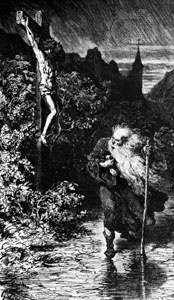wandering Jew
in horticulture, any of several popular houseplants in the family Commelinaceae. See spiderwort; Zebrina.
legendary character
 in Christian legend, character doomed to live until the end of the world because he taunted Jesus on the way to the Crucifixion. A reference in John 18:20–22 to an officer who struck Jesus at his arraignment before Annas is sometimes cited as the basis for the legend. The medieval English chronicler Roger of Wendover describes in his Flores historiarum how an archbishop from Greater Armenia, visiting England in 1228, reported that there was in Armenia a man formerly called Cartaphilus who claimed he had been Pontius Pilate's doorkeeper and had struck Jesus on his way to Calvary, urging him to go faster. Jesus replied, “I go, and you will wait till I return.” Cartaphilus was later baptized Joseph and lived piously among Christian clergy, hoping in the end to be saved. An Italian variant of the story named the culprit as Giovanni Buttadeo (“Strike God”).
in Christian legend, character doomed to live until the end of the world because he taunted Jesus on the way to the Crucifixion. A reference in John 18:20–22 to an officer who struck Jesus at his arraignment before Annas is sometimes cited as the basis for the legend. The medieval English chronicler Roger of Wendover describes in his Flores historiarum how an archbishop from Greater Armenia, visiting England in 1228, reported that there was in Armenia a man formerly called Cartaphilus who claimed he had been Pontius Pilate's doorkeeper and had struck Jesus on his way to Calvary, urging him to go faster. Jesus replied, “I go, and you will wait till I return.” Cartaphilus was later baptized Joseph and lived piously among Christian clergy, hoping in the end to be saved. An Italian variant of the story named the culprit as Giovanni Buttadeo (“Strike God”).The legend was revived in 1602 in a German pamphlet, “Kurze Beschreibung und Erzählung von einem Juden mit namen Ahasverus” (“A Brief Description and Narration Regarding a Jew Named Ahasuerus”). This version, in which the name Ahasuerus is first given to the wanderer, who was not baptized, describes how at Hamburg in 1542 Paulus von Eitzen (d. 1598), a Lutheran bishop of Schleswig, Ger., met an aged Jew who claimed to have taunted Jesus on the way to the Crucifixion. He received the reply “I stand and rest, but you will go on.” The popularity of the pamphlet may have been the result of the anti-Jewish feeling aroused by the belief that the Antichrist would appear in 1600 and be aided by the Jews. The pamphlet was rapidly translated into other languages of Protestant Europe. Appearances of the wandering Jew were frequently reported in various European cities. As late as 1868 he was reputedly seen in Salt Lake City, Utah.
The wandering Jew has been the subject of many plays, poems, novels, and works of visual art. One of the best-known literary treatments is Eugène Sue's Romantic novel Le Juif errant, 10 vol. (1844–45; The Wandering Jew), but this anti-Jesuit melodrama has little to do with the original legend. Gustave Doré produced a series of 12 wood engravings on the theme in 1856.
- Fairbanks
- Fairbanks, Charles Warren
- Fairbanks, Douglas
- Fairchild, David Grandison
- Fairchild, Mary Salome Cutler
- Fairchild Semiconductor Corporation
- Fair Deal
- Fairfax
- Fairfax, Edward
- Fairfax, Ferdinando Fairfax, 2nd Baron
- Fairfax M. Cone
- Fairfax, Thomas Fairfax, 3rd Baron
- Fairfield
- Fairfield Porter
- Fairfield University
- Fairhaven
- Fair Labor Standards Act
- Fairleigh Dickinson University
- Fairmont
- fair-trade law
- Fairway
- Fairweather, Mount
- fairy
- fairy bluebird
- fairy ring